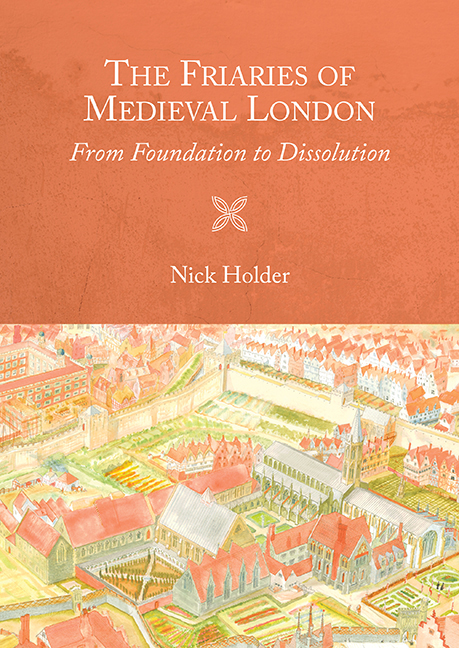Book contents
- Frontmatter
- Contents
- List of Illustrations and Tables
- Contributors
- Acknowledgements
- Abbreviations
- Introduction
- Part I The Nine London Friaries
- Part II The London Friars and their Friaries
- 10 Churches
- 11 Precincts and the Use of Space
- 12 Architecture and Architectural Fragments of the London Friaries
- 13 Floor Tiles and Building Materials from the London Friaries
- 14 Water Supply
- 15 Economy
- 16 Spiritual Life and Education in the London Friaries
- 17 Burial and Commemoration in the London Friaries
- 18 London Friars and Londoners
- 19 Dissolution
- Conclusions
- Timeline
- Bibliography
- Index
- Miscellaneous Endmatter
18 - London Friars and Londoners
from Part II - The London Friars and their Friaries
Published online by Cambridge University Press: 16 May 2018
- Frontmatter
- Contents
- List of Illustrations and Tables
- Contributors
- Acknowledgements
- Abbreviations
- Introduction
- Part I The Nine London Friaries
- Part II The London Friars and their Friaries
- 10 Churches
- 11 Precincts and the Use of Space
- 12 Architecture and Architectural Fragments of the London Friaries
- 13 Floor Tiles and Building Materials from the London Friaries
- 14 Water Supply
- 15 Economy
- 16 Spiritual Life and Education in the London Friaries
- 17 Burial and Commemoration in the London Friaries
- 18 London Friars and Londoners
- 19 Dissolution
- Conclusions
- Timeline
- Bibliography
- Index
- Miscellaneous Endmatter
Summary
TRADITIONAL monks and nuns lived a static and enclosed life in their convents, following St Benedict's rule of stabilitas loci; friars certainly had elements of this lifestyle but had a dual focus, looking inwards at the community and outwards at the town. The friars’ liturgy and in-house schools represent the inward aspect (Chapter 16: Spiritual Life and Education in the London Friaries), but other aspects of the friars’ lives were outward looking: they regularly stepped outside their precincts, going out into the city and supplying what might be termed spiritual services to Londoners, whether native, foreign or alien. These same Londoners increasingly came into the friars’ convents (in life and in death) to ‘consume’ spiritual services and to use the spaces of the convents in a number of other ways; a comparison can be drawn between the thriving mercantile economy of London and the developing ‘salvation market’ of debits (sin) and credits (intercession and good works). The relations between friars and Londoners were therefore quite extensive and surprisingly varied. It is notable that the surviving place-names relating to the London friaries nearly all derive from the way that Londoners saw or talked about the friars outside the friaries: ‘Blackfriars’ describes the black cloak the Dominicans wore in the street, not the white tunic and scapular they wore in church and cloister; ‘Whitefriars’ the white cloak of the Carmelites rather than their undyed wool tunic. And the modern street of Crutched Friars takes its name from the way that Londoners pronounced the Latin name for the Crossed friars: cruciferi (presumably ‘crutchy-furry’).
The friars’ patrons
Ordinary Londoners had begun to act as founders of religious institutions in the late twelfth century when the mercer Walter Brown (Brunus) and his wife Rosia endowed the hospital and priory of St Mary Spital. However, to found a religious house, especially one in London, was an expensive business and the founders of most houses were higher ranking landowners and nobility. The priory of the Sack friars was founded directly by Henry III and his daughter-in-law Eleanor of Castile, and the king was certainly a prominent supporter of many English monastic houses.
- Type
- Chapter
- Information
- The Friaries of Medieval LondonFrom Foundation to Dissolution, pp. 293 - 304Publisher: Boydell & BrewerPrint publication year: 2017

